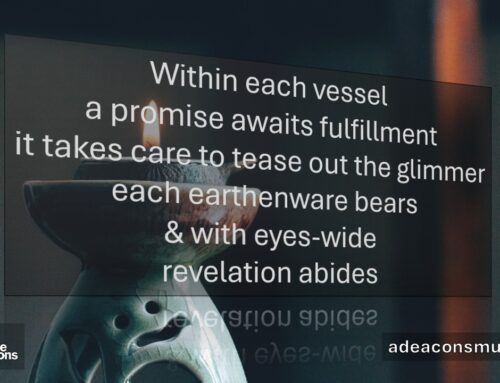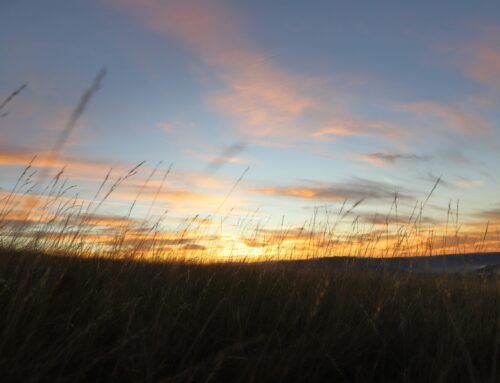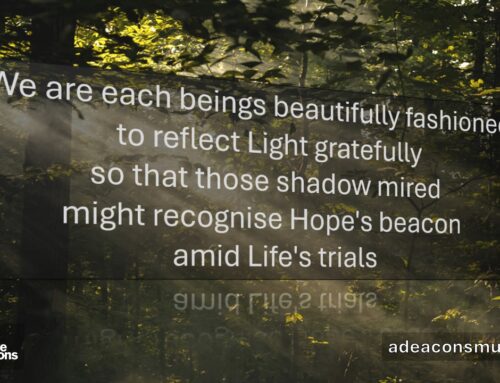For the 2018 Lenten Journey, I am excited to once again be creatively collaborating with Little Britain United Church. Each worship service and blog will be informed by a resource created by Matthew L. Kelly, who is currently in ministry at Christ United Methodist Church in Franklin, Tennessee, USA. I pray that this “Giving It Up” Lenten Journey proves of interest and nurtures the gift of this ongoing conversation with you seekers and readers, who continue to graciously extend trust by engaging with A Deacon’s Musing blog.
The Resurrection of Jesus
20 Early on the first day of the week, while it was still dark, Mary Magdalene came to the tomb and saw that the stone had been removed from the tomb. 2 So she ran and went to Simon Peter and the other disciple, the one whom Jesus loved, and said to them, “They have taken the Lord out of the tomb, and we do not know where they have laid him.” 3 Then Peter and the other disciple set out and went toward the tomb. 4 The two were running together, but the other disciple outran Peter and reached the tomb first. 5 He bent down to look in and saw the linen wrappings lying there, but he did not go in. 6 Then Simon Peter came, following him, and went into the tomb. He saw the linen wrappings lying there, 7 and the cloth that had been on Jesus’ head, not lying with the linen wrappings but rolled up in a place by itself. 8 Then the other disciple, who reached the tomb first, also went in, and he saw and believed; 9 for as yet they did not understand the scripture, that he must rise from the dead. 10 Then the disciples returned to their homes.
Jesus Appears to Mary Magdalene
11 But Mary stood weeping outside the tomb. As she wept, she bent over to look into the tomb; 12 and she saw two angels in white, sitting where the body of Jesus had been lying, one at the head and the other at the feet. 13 They said to her, “Woman, why are you weeping?” She said to them, “They have taken away my Lord, and I do not know where they have laid him.” 14 When she had said this, she turned around and saw Jesus standing there, but she did not know that it was Jesus. 15 Jesus said to her, “Woman, why are you weeping? Whom are you looking for?” Supposing him to be the gardener, she said to him, “Sir, if you have carried him away, tell me where you have laid him, and I will take him away.” 16 Jesus said to her, “Mary!” She turned and said to him in Hebrew, “Rabbouni!” (which means Teacher). 17 Jesus said to her, “Do not hold on to me, because I have not yet ascended to the Father. But go to my brothers and say to them, ‘I am ascending to my Father and your Father, to my God and your God.’” 18 Mary Magdalene went and announced to the disciples, “I have seen the Lord”; and she told them that he had said these things to her.
Easter: It's the central underpinning of the Christian journey that we revisit each year. It is more than a ritual or initiation: it is neither a test, nor a badge of accomplishment. We are reminded every time we walk through the Lenten season of the realities of suffering and death, shadows and fear that have in the past, are currently, or in the future will touch our lives. As Christians, however, this recognition of death's presence is not the final word. This is not a cynical or apathetic intellectual exercise. Easter is not bound by literalism or metaphor. It is the quintessential image, story, and narrative of hope.
I have previously explored where the theology of resurrection meets our daily lives. The variety of ways in which it can be explored is, well, unlimited. Christians have been discussing, debating, weeping, and laughing about letting go of death for millennia. I suspect this will not change.
We all live in mortal shells, which are finite in nature. I believe the reoccurring nature of walking to the "hallelujahs" of Easter requires us to reflect on the ways we have seen the Easter story lived out in our lives. This year has been no different.
I believe that Mary's story, which informs this week's blog (see Tab above), speaks directly to our human condition. In a place of fear and loss, likely anger and frustration, Mary could not initially see the promise. She was appropriately stuck in death, and even though the new life was present, even though the Resurrected Christ stood gracefully before her, she could not see him. I cannot imagine that any of us would be able to do any better.
It takes intention, discipline in the Christian tradition, to be mindful and present to more than our own reality. It's easy to focus on a lingering cold winter that stretches into spring and fail to see life arriving and blooming Whether trees budding, robins returning, or flowers emerging through remaining snow, without fostering attention in ourselves and others, we can easily focus on despair and death. To let that go and see something new requires conversations and reflection. Deeply breathing, willing to stumble, and, finally, to recognise we are not alone.
This faith journey is not about isolation or individuality. Those may be components of our own journey, but Mary does not stay with the Resurrected One. She returns to the community to share, marvel, and listen. She brings this hope to inspire others who are lost in fear and doubt; she now comes bearing light. So, in these shadowed times, let me offer but two places where I have seen death released and resurrection arise:
C.S. Lewis, one of those rare Christian theologians and writers who crosses divides, explained miracles in this way:
Nothing can seem extraordinary until you have discovered what is ordinary. Belief in miracles, far from depending on an ignorance of the laws of nature, is only possible in so far as those laws are known.
Death: where we focus our attention and our conversations can become a feedback loop – an echo chamber. The Christian invitation to wonder and be curious, to reject ignorance, reveals a world of possibility. One in which new life, hope, resurrection abound. This singular event upon which Christians reflect and act occurs not in the vacuum of a magic wand wielding Creator, but one that becomes more apparent the more we engage in the intention of recognising miracles.
Miracles are not acts outside of what Lewis calls the "laws of nature." They occur within them, even though they should not. Whether death confronts us in the violence we perpetuate upon one another or it is part of the life cycle gone awry, seeing hope dance between the metaphor and the literal is an event into which we are invited to join every moment of our lives.









Yes, Good Friday and this Easter weekend bring us to as you have pointed out leaving death behind. Our Lord and Savior over came the boundary of death to be resurrected to show us what is to be for all of us when he returns. Today children have to face death in their schools in the United States of America. This is unfortunate however, once these children become of age to vote things are going to change for the better down there. They are the future of this world and we should all learn from them that as you said leave death behind. God bless them all and God open the ears, minds and hearts of those in power now to listen to the shouts for gun control today and do exactly this for their children.
What a lovely prayerful reflection James: thanks! As i was reading it I could hear the “Alive” song plaything that ends in the blog. Nicely complementing your shared wisdom!